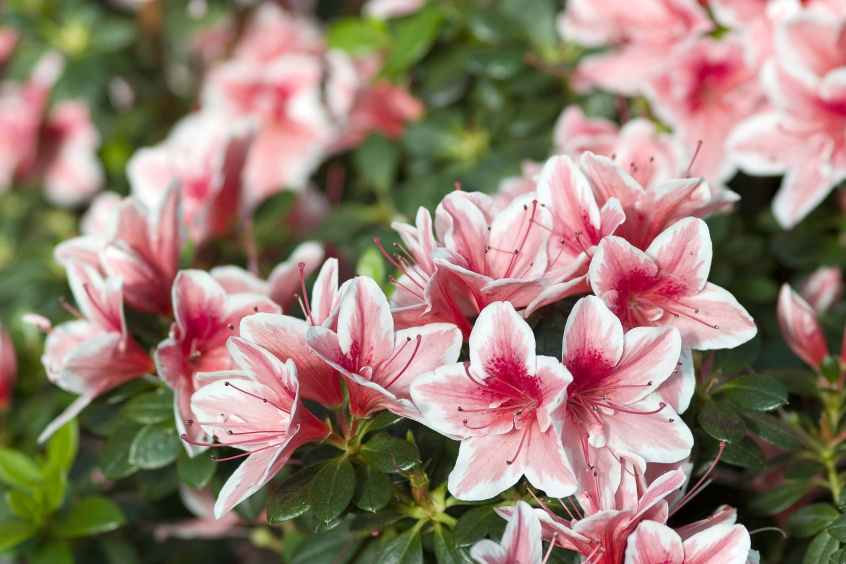Azaleas herald spring with a burst of vibrant color and lush greenery. Their bright, trumpet-shaped flowers create dazzling displays that light up gardens and woodland edges alike. Beyond their beauty, azaleas symbolize passion and temperance, enchanting gardeners with their delicate blossoms and rich heritage.
These shrubs thrive in acidic, well-drained soils and dappled shade, making them perfect for woodland gardens or shaded borders. With proper care, azaleas will fill your landscape with spectacular blooms year after year.

Portrait of the Azalea
Azaleas belong to the Rhododendron genus in the Ericaceae family. They are prized for their profuse flowering and compact, shrub-like form. Common species include Rhododendron indicum and Rhododendron simsii.
- Type: Deciduous or evergreen shrub
- Family: Ericaceae
- Common names: Azalea
Foliage and Form
Azaleas typically grow as medium-sized shrubs with dense, ovate leaves. Depending on the species, they may be deciduous or evergreen, offering year-round interest through foliage or seasonal blooms.
- Height: 0.6–3 m (2–10 ft)
- Spread: 0.6–2.5 m (2–8 ft)
- Growth Habit: Bushy, compact shrub
Blooms and Fragrance
Azalea flowers come in shades of white, pink, red, orange, and purple, often appearing in clusters. While most azaleas have little scent, some cultivars offer a light, sweet fragrance.
- Bloom Time: Spring (April to June)
- Color: White, pink, red, orange, purple
- Fragrance: Mild to none, some lightly fragrant cultivars
The Right Time to Plant, Prune, and Enjoy Azalea
| Month | Planting | Flowering | Pruning |
|---|---|---|---|
| January | ❌ | ❌ | ✅ Light pruning (remove dead wood) |
| February | ✅ (container plants) | ❌ | ✅ Shaping cuts |
| March | ✅ (bare-root & containers) | ❌ | ✅ Light pruning, shaping |
| April | ❌ | ✅ (start) | ❌ |
| May | ❌ | ✅ | ❌ |
| June | ❌ | ✅ (late blooms) | ✅ Light pruning after flowering |
| July | ❌ | ❌ | ✅ Remove dead or diseased wood |
| August | ❌ | ❌ | ✅ Summer shaping cuts |
| September | ❌ | ❌ | ✅ Clean-up pruning |
| October | ✅ (container plants) | ❌ | ❌ |
| November | ✅ (bare-root) | ❌ | ✅ Remove dead branches |
| December | ❌ | ❌ | ✅ Light pruning |
✅ = Recommended ❌ = Not advised
Watering, Sunlight, and Environment for Azalea
Watering
- Azaleas prefer consistently moist soil but dislike waterlogged conditions.
- Water deeply once or twice a week, especially during dry spells.
- Mulching helps retain soil moisture and regulate temperature.
Sunlight
- Azaleas thrive best in partial shade or dappled sunlight.
- Avoid harsh afternoon sun, which can scorch leaves and reduce blooms.
Indoor vs Outdoor
- Azaleas are outdoor shrubs suited to garden beds or woodland settings.
- Can be grown in pots but require protection from extreme temperatures.
Temperature
- Prefer mild climates; hardy in USDA zones 6–9.
- Protect from late spring frosts and extreme heat.
- Ideal temperature range: 12–24°C (54–75°F)
Ideal Soil Conditions for Growing Azalea
| Soil Feature | Optimal Condition | Why It Matters |
|---|---|---|
| Soil Type | Acidic, rich in organic matter | Supports nutrient uptake |
| Texture | Light, well-draining | Prevents root rot |
| Drainage | Excellent | Avoids soggy roots |
| Moisture | Consistently moist | Maintains healthy growth |
| Soil pH | Acidic (4.5–6.0) | Essential for nutrient availability |
| Fertility | Moderate | Supports flowering without excess foliage |
Common Problems & Solutions
| Issue 🐾 | Symptoms 🔍 | Solutions 🛠️ |
|---|---|---|
| Leaf Gall 🌿 | Swollen, distorted leaves | Remove affected parts, improve airflow |
| Powdery Mildew 🍂 | White powder on leaves | Apply fungicides, improve ventilation |
| Root Rot 💧 | Wilting, yellowing leaves | Ensure good drainage, avoid overwatering |
| Azalea Lace Bug 🐜 | Yellow stippling, leaf damage | Use insecticidal soap or neem oil |
Azaleas bring an explosion of color to shaded garden corners, blending elegance with resilience. With rich, acidic soil and careful attention to watering and pruning, these shrubs will become a beloved focal point in your garden landscape.